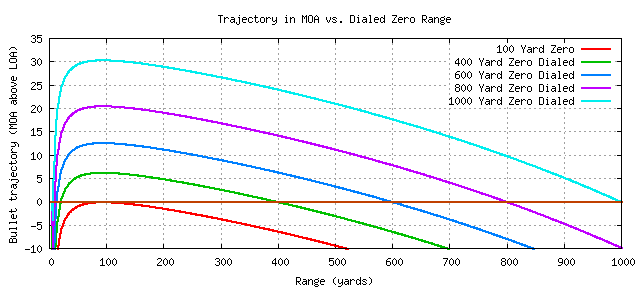Trajectory Effects Of Dialing Elevation
The following graph shows the effects on bullet path of dialing elevation. The red trajectory
is with a 100 yard zero. Next, the shooter wants to engage a target at 400 yards, so he dials the
elevation specified by his data-card for 400 yards, which results in the green trajectory. He
repeats the same procedure for 600 yards (dark blue), 800 yards (purple), and 1000 yards (cyan).
Data Confirmation by Shooting
It is important to verify computed data by actually shooting targets at various distances and
looking at the actual hits (or misses) to determine if the elevation values are correct. Shooting
known-distance targets every 100 yards out to the maximum range is a good way to do this.
Desired Sighting System Capabilities
Let's look at the things we want to accomplish with the rifle sighting system:
Optical Considerations
Magnified rifle optics have several salient optical properties which we need to understand before
discussing the capability trade-offs later:
Parallax Error
Parallax is the error in apparent POA vs. actual POA due to misalignment of the shooter's eye
vs. the scope's axis. A scope can be set to be parallax error free at one distance. A scope
either has adjustable or fixed parallax. Fixed parallax means the distance at which there is no
error is fixed to something like 100 or 200 yards from the factory. Most tactical scopes have
adjustable parallax, which means the user can adjust the parallax error free distance on the fly
to reduce parallax error whatever the current target's distance.
First Focal Plane vs. Second Focal Plane Definition
Variable-magnification optics can have a first focal plane (FFP) or second focal plane (SFP) reticle
configuration. A first-focal (FFP) reticle's features always demarcate the same angular
measurement regardless of the scope magnification setting. The reticle will appear to "shrink"
and "grow" with the target area as the magnification is adjusted.
A second focal plane (SFP) reticle demarcates angular distance that depends on the scope magnification setting. The reticle appears to stay constant as the target area shrinks and grows as the magnification is adjusted. A fixed power optic is FFP by definition. Capability Tradeoffs
With the background out of the way, What are the capability trade-offs of the different feature choices?
Elevation Adjustment Methods
Elevation specification can be done by external knobs (or direct mount adjustment, e.g. the
Elcan), via reticle features, or a combination.
Knobs: If the primary method of specifying elevation is by external knob, the knob will have "click" values. Each time the knob "clicks" to the next setting, the elevation setting will be changed by the click amount. Typical values of clicks are 1/4 MOA, 1/2 MOA, 1 MOA, or 0.1MIL. |

